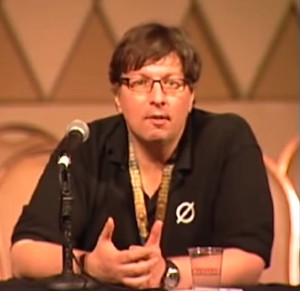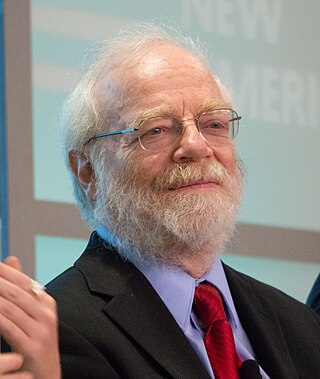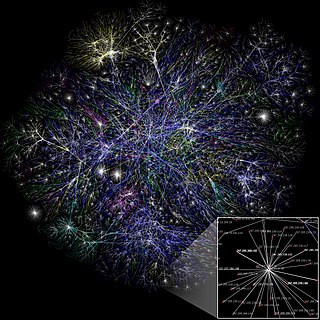Related Research Articles

Bell Labs is an American industrial research and scientific development company credited with the development of radio astronomy, the transistor, the laser, the photovoltaic cell, the charge-coupled device (CCD), information theory, the Unix operating system, and the programming languages B, C, C++, S, SNOBOL, AWK, AMPL, and others. Ten Nobel Prizes and five Turing Awards have been awarded for work completed at Bell Laboratories.
Robert H. Morris Sr. was an American cryptographer and computer scientist.

Virtual Network Computing (VNC) is a graphical desktop-sharing system that uses the Remote Frame Buffer protocol (RFB) to remotely control another computer. It transmits the keyboard and mouse input from one computer to another, relaying the graphical-screen updates, over a network.

Mary Ann Horton, is a Usenet and Internet pioneer. Horton contributed to Berkeley UNIX (BSD), including the vi editor and terminfo database, created the first email binary attachment tool uuencode, and led the growth of Usenet in the 1980s.
Internet security is a branch of computer security. It encompasses the Internet, browser security, web site security, and network security as it applies to other applications or operating systems as a whole. Its objective is to establish rules and measures to use against attacks over the Internet. The Internet is an inherently insecure channel for information exchange, with high risk of intrusion or fraud, such as phishing, online viruses, trojans, ransomware and worms.

Matt Blaze is an American researcher who focuses on the areas of secure systems, cryptography, and trust management. He is currently the McDevitt Chair of Computer Science and Law at Georgetown University, and is on the board of directors of the Tor Project.
An information security audit is an audit of the level of information security in an organization. It is an independent review and examination of system records, activities, and related documents. These audits are intended to improve the level of information security, avoid improper information security designs, and optimize the efficiency of the security safeguards and security processes.
In cryptography, the interlock protocol, as described by Ron Rivest and Adi Shamir, is a protocol designed to frustrate eavesdropper attack against two parties that use an anonymous key exchange protocol to secure their conversation. A further paper proposed using it as an authentication protocol, which was subsequently broken.

Steven M. Bellovin is a researcher on computer networking and security who has been a professor in the computer science department at Columbia University since 2005. Previously, Bellovin was a fellow at AT&T Labs Research in Florham Park, New Jersey.
Trusted Information Systems (TIS) was a computer security research and development company during the 1980s and 1990s, performing computer and communications (information) security research for organizations such as NSA, DARPA, ARL, AFRL, SPAWAR, and others.
A network telescope is an Internet system that allows one to observe different large-scale events taking place on the Internet. The basic idea is to observe traffic targeting the dark (unused) address-space of the network. Since all traffic to these addresses is suspicious, one can gain information about possible network attacks as well as other misconfigurations by observing it.
Crack is a Unix password cracking program designed to allow system administrators to locate users who may have weak passwords vulnerable to a dictionary attack. Crack was the first standalone password cracker for Unix systems and the first to introduce programmable dictionary generation as well.

The Internet Mapping Project was started by William Cheswick and Hal Burch at Bell Labs in 1997. It has collected and preserved traceroute-style paths to some hundreds of thousands of networks almost daily since 1998. The project included visualization of the Internet data, and the Internet maps were widely disseminated.
Firewalls and Internet Security: Repelling the Wily Hacker is a 1994 book by William R. Cheswick and Steven M. Bellovin that helped define the concept of a network firewall. Describing in detail one of the first major firewall deployments at AT&T, the book influenced the formation of the perimeter security model, which became the dominant network security architecture in the mid-1990s.

Marcus J. Ranum is a computer and network security researcher. He is credited with a number of innovations in firewalls, including building the first Internet email server for the whitehouse.gov domain, and intrusion detection systems. He has held technical and leadership positions with a number of computer security companies, and is a faculty member of the Institute for Applied Network Security.
A distributed firewall is a security application on a host machine of a network that protects the servers and user machines of its enterprise's networks against unwanted intrusion. A firewall is a system or group of systems that implements a set of security rules to enforce access control between two networks to protect the "inside" network from the "outside" network. They filter all traffic regardless of its origin—the Internet or the internal network. Usually deployed behind the traditional firewall, they provide a second layer of defense. The advantages of the distributed firewall allow security rules (policies) to be defined and pushed out on an enterprise-wide basis, which is necessary for larger enterprises.
In computing, a firewall is a network security system that monitors and controls incoming and outgoing network traffic based on predetermined security rules. A firewall typically establishes a barrier between a trusted network and an untrusted network, such as the Internet.
Markus Jakobsson is a computer security researcher, entrepreneur and writer, whose work is focused on the issue of digital security.

Mohamed M. Atalla was an Egyptian-American engineer, physicist, cryptographer, inventor and entrepreneur. He was a semiconductor pioneer who made important contributions to modern electronics. He is best known for inventing, along with his colleague Dawon Kahng, the MOSFET in 1959, which along with Atalla's earlier surface passivation processes, had a significant impact on the development of the electronics industry. He is also known as the founder of the data security company Atalla Corporation, founded in 1972. He received the Stuart Ballantine Medal and was inducted into the National Inventors Hall of Fame for his important contributions to semiconductor technology as well as data security.
The following outline is provided as an overview of and topical guide to computer security:
References
- ↑ "Steven Bellovin is this year's recipient of the ESORICS Outstanding Research Award". www.cs.columbia.edu.
- ↑ "Who Invented the Firewall?". Dark Reading. 15 January 2008.
- ↑ "Goodbye Gibberish: Making Passwords Easier to Remember". NBC News. Archived from the original on September 22, 2021.
- ↑ "Bill Cheswick's Thumbnail Experiments".